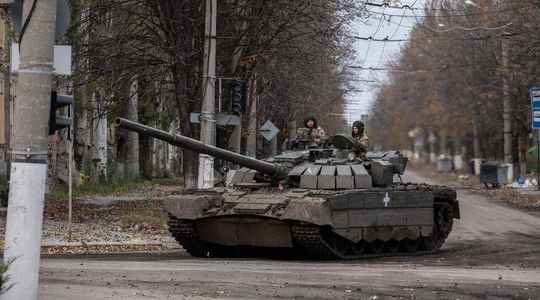Arms vigil around the city of Kherson in southern Ukraine. “Everything is clear. The Russians are restocking, strengthening their grouping there, Ukrainian presidential adviser Oleksiy Arestovych said late Tuesday evening. This means that no one is preparing to back down. On the contrary, the harshest battles will take place in Kherson.” For several weeks, Ukrainian forces have been advancing in the region of the same name, annexed by the Kremlin at the end of September. And are approaching its administrative capital, conquered by the Russians in the first days of the war.
Due to its location on the west bank of the Dnieper River, this city, with nearly 300,000 inhabitants before the conflict, is a strategic bridgehead for Moscow. If the Russians have begun the evacuation of thousands of civilians to other occupied territories located further east, the Ukrainian authorities believe that Putin’s troops do not intend to leave the city without a fight. A major challenge for the Ukrainian forces.
Advantage to defender
“It will be the first urban battle where the Ukrainians are on the offensive, notes Michel Goya, former colonel of the navy troops, now a historian of the war. We know that it is an environment which considerably benefits the defender, giving it multiple places to retreat to.” Enough to offer the Russians the possibility of encysting themselves in the city, to exhaust the Ukrainian troops. “If the Russian army clings to Kherson as part of an attrition strategy, it could be as complex as it is costly in men for Ukraine, adds General (2S) Jérôme Pellistrandi, editor-in-chief of the National Defense Review. In urban combat, the attacker usually has to impose a six-to-one odds on the defender.”
Especially since the Ukrainian forces will be faced with another imperative: to try to reconquer the city without destroying it. Unlike other major Ukrainian cities ravaged by Russian artillery at the time of their conquest – such as Mariupol, which was over 90% destroyed last spring – Kherson is one of the rare cities to have been relatively spared by the destructions. Keeping, de facto, a strong economic potential. “It is unlikely that the Ukrainian forces will agree to turn Kherson into a field of ruins, abounds General Pellistrandi. Moreover, even if evacuations are underway, there will inevitably remain civilians on the spot. So the Ukrainian army will seek to limit losses. Reducing, at the same time, its capacity for action.
Russian propaganda would not refrain from exploiting to its advantage any collateral victim in the population. On October 21, the occupation authorities thus accused the Ukrainian army of having killed four people evacuating the city, in a strike against the Antonovski bridge linking the two banks of the Dnieper. For the time being, “more than 70,000” civilians have left their homes “in one week”, according to initial figures given on Wednesday by Russia.
“Stalingrad on the Dnieper”
However, the situation could quickly become complicated for Russian forces trapped between those of Ukraine and the waters of the Dnieper. An advantage that the Ukrainian troops could exploit to organize the siege of the city. “The battle could turn into Stalingrad on the Dnieper, believes Michel Goya. As soon as Russian supplies are cut off, the city will no longer be tenable in the long term.” Following an intense campaign of strikes targeting the bridges linking the city to the rest of the occupied territories, the Ukrainian forces had already managed this summer to largely disrupt Russian supplies.
Problem: if the Russians have sufficient stocks of food and ammunition on site, the fall of the city could take many months. Be that as it may, the level of combativeness of the Russian forces will be decisive. “We know that Russian morale has not been optimal in recent weeks, and has tended to deteriorate, gauges General Pellistrandi. But seasoned troops could be more inclined to withstand a siege.”
However, it is not guaranteed that Moscow can still count on experienced soldiers in the area. The Ukrainian command reported on October 22 that the Russian officer corps had been moved east of the Dnieper, while newly mobilized men remained stationed at the line of contact. Their failure to hold the city would be a major humiliation for the Kremlin. “It would be the first major city annexed by the Russians to fall into the hands of the Ukrainians, notes Michel Goya. It would be a major failure, potentially heavy with consequences.”
